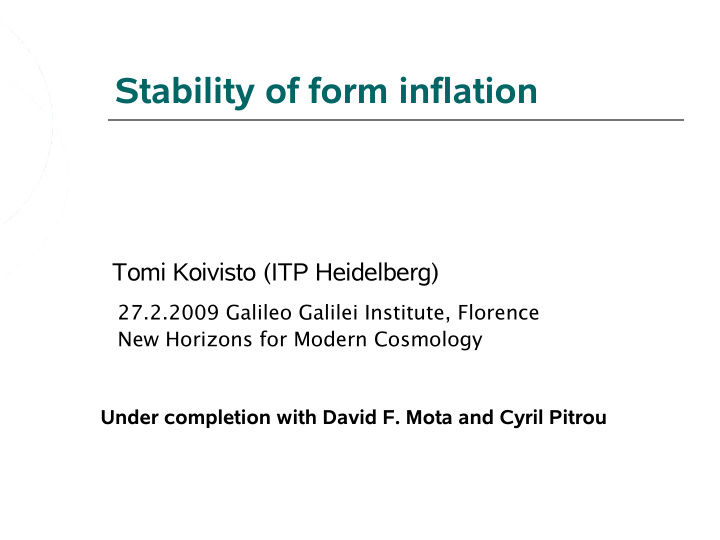



Stability of form inflation Tomi Koivisto (ITP Heidelberg) 27.2.2009 Galileo Galilei Institute, Florence New Horizons for Modern Cosmology Under completion with David F. Mota and Cyril Pitrou
Why forms? To test the robustness of scalar is it the only natural possibility? scalars have not been detected yet Forms exist in fundamental theories string theory nonsymmetric gravity Possibility to generate anisotropy present anomalies in CMB Planck could detect small anisotropy
Outline The question: can single-field inflation be generalised to forms? Furthermore: are the resulting models stable (shear, perturbations, ghosts)? We will: 0) Introduce the action 1) Discuss vector & 2form: anisotropic inflation 2) Discuss 3form & 4form: new isotropic inflation 3) Summarise and look out
Stability in flat space Parity and Lorentz-invariant,quadratic Ghost or nonlocality unless a(a+b)=0 van Nieuwenhuizen, Nucl. Phys. B69, 478 (1973) If a=-b: Maxwell recovered If a=0: Dual theory
Stability in curved space General curvature couplings: FRW stability: c=d Schwarzchild solutions : d=0 …we’re left with a coupling to R Janssen and Prokopec, CQG 23, 467 (2006)
The models Thus we consider the case Notations: EOM:
Stückelberg form: We get the Lagrangian Gauge invariance restored, for an (n-1) form Δ: We can choose a gauge where Thus: eff. mass negative -> a (n-1)-ghost !
Vector field cosmology Ford: Phys.Rev.D40:967 (1989) FRW symmetry problematic : A spatial vector not compatible Time-like field trivial Proposed solutions: Introduce a “triad” of three spatial (stability?) Armendariz-Picon: JCAP 0407:007 (2004) Introduce a large number of random fields Golovnev, Mukhanov & Vanchurin: JCAP 0806 (2008 ) (tractability?) But generation of anisotropy was among our original motiv
Vector field: Background In Bianchi I universe, a vector must be aligned along a spatial axis! So, consider axisymmetry with shear σ: The EOM for the comoving field X=A/a is For slow roll one needs conformal coupling Golovnev, Mukhanov & Vanchurin JCAP 0806 (2008) TK & D. Mota: JCAP 0806 (2008) More general couplings: TK & D.Mota: JCAP 0808 (2008)
Vector field: perturbations Consider A=(α0, α,i+αi) in Minkowski Solve α0 and plug back: If M^2<0, α becomes a ghost and now indeed M^2 = -R/6+m^2~-H^2 The ghost is confirmed by full computation Himmetoglu, Contaldi & Peloso arXiv:0812.1231 We already learned it with Stϋckelberg!
Other vector models: remarks Several cases exist in the literature studying inflation with “vector impurity” e.g.: Kanno, Kimura, Soda, Yokoyama JCAP 0808:034,2008 Our arguments apply to these models as such though the vector isn’t dominating The fixed-norm case L =− α 1 ∇ A 2 − α 2 F 2 − α 3 ∇⋅ A 2 λ A 2 − m 2 Ackerman, Carroll and Wise Phys.Rev.D75:083502,2007 has a similar instability of the longitudinal vector mode
Two-form: background Symmetry allows only A=XdyΛdz/b. Then Thus, slow roll requires conformal/2 coupling Now effective mass contributions remain due to, in addition to shear, -εH^2 At the level of action: M^2 = -R/12+m^2 ~ -H^2/2, Stϋckelberg says we expect a vector ghost
2-form: perturbations Go to Minkowski and decompose with transverse potentials with further decomposition we can write the constraints as Plugging back into action yields the result…
2form: perturbations The action for perturbations is: There is a well behaved scalar part There is also a vector ghost when M^2<0 We conclude that massive 1- or 2-forms cannot support inflation
Three-form Symmetry allows only FRW and The EOM becomes Coupling nothing but introduces large mass -> set ξ = 0 Promote the mass term into V(x^2) This time S. only requires V>0 for stability
Three-form X is not equivalent to scalar, but Always ρ = + kinetic + potential If V is constant p = - kinetic - potential If V is mass term p = - kinetic + potential It seems a minimally coupled 3-form inflates easily Phantom inflation occurs whenever V’(A^2)<0
Four-form The only possibility: A=X(t)dtΛdxΛdyΛdz the kinetic term is trivial. Call A^2 = φ Algebraic EOM: Plugging back gives an f(R) theory: If V is quadratic, this just the R^2 inflation Starobinsky, Phys. Lett. B91, 99 (1980)
Dual Maps A into the orthogonal subspace of (d-n)-forms The field strenght transforms as ¿ F =− 1 d − n d ∇⋅∗ A yielding the only stable kinetic term for 2form in flat space The resulting theory is not equivalent since ksi EOM:
Reformulation So one may write the dual as a (d-n-1)-index generalisation of a massive scalar L =− n 1 ! 2 − 1 2 φ 2 − V A 2 [∇ φ ] 2 [∇ φ ] 2 m 2 ξ RA 2 A Φ n=d-1 Mass term Canonical kinetic Quintessence Nonquadratic Noncanonical K-essence potential kinetic Dual kinetic Mass term Chaotic inf. Nonquadratic General General scalar dual kinetic potential potential
Forms in axisymmetric B(I) dt dt dx dx dy dy dz dz ∇⋅¿ A F=0 Dynamical 1 st order ∇⋅¿ A 0 th order dt dt dx dx dy dy dz dz
form #dof shear coupling comments 0 1 0 0 A scalar field *0=4 1 0 0 1 st order EOM 1 4 ~X^2 -1/6 Scalar ghost appears *1=3 4 0 0 1 st order EOM 2 6 ~X^2 -1/12 Vector ghost appears *2=2 6 Not 0 0 1 st order EOM 3 4 0 0 Isotropic inflation *3=1 4 0 0 Equivalent to scalar 4 1 0 not zero Metric f(R) gravity *4=0 1 0 not zero Equivalent
Outlook To find stable models supporting anisotropy Go to nonquadratic theories Consider scalar inflaton + forms To see if the new isotropic inflations are viable Check stability of perturbations Compute the fluctuation spectrum Other applications Origin of 4 large dimensions Dark energy
Recommend
More recommend